for consumption product can be obtained from amazon.com
for zimbrar product have not been sourced yet
Prunus mahaleb
Mahaleb
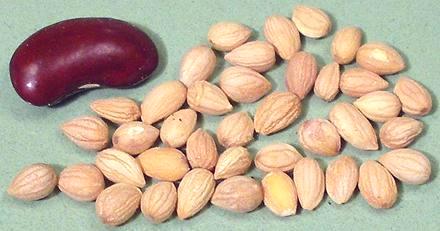 [Bird Cherry; Mahlab, Mahleb (Mid East, Anatolia, Armenia); Mahlepi (Greek); St Lucie Cherry, Mahaleb Cherry, Prunus mahaleb]
[Bird Cherry; Mahlab, Mahleb (Mid East, Anatolia, Armenia); Mahlepi (Greek); St Lucie Cherry, Mahaleb Cherry, Prunus mahaleb]
This cherry tree is native from central and southern Europe east to Pakistan and Kyrgystan, and south to Morocco and Lebanon. It produces small red cherries that are thin fleshed and bitter, eaten mainly by birds. The cherry pits are broken open to release the kernel, which is used as a spice for holiday sweets and cakes, particularly in Greece, Turkey, Armenia, Cyprus, Lebanon. Syria and Iraq. It is also used to flavor Nabulsi cheese.
It is described as tasting like a combination of cherry and bitter almond. Myself I don't detect much cherry, but it has a moderately bitter aromatic resin taste. The specimen photo shows seed kernels 0.2 inch (5 mm) long purchased from a market in Los Angeles. It is more available in powdered form, but that must be fresh as it degrades rapidly. The seed kernels also must not be stored long, as they become rancid within a year or so.
More on Roses - Stone Fruit.
 [Bird Cherry; Mahlab, Mahleb (Mid East, Anatolia, Armenia); Mahlepi (Greek); St Lucie Cherry, Mahaleb Cherry, Prunus mahaleb]
[Bird Cherry; Mahlab, Mahleb (Mid East, Anatolia, Armenia); Mahlepi (Greek); St Lucie Cherry, Mahaleb Cherry, Prunus mahaleb]This cherry tree is native from central and southern Europe east to Pakistan and Kyrgystan, and south to Morocco and Lebanon. It produces small red cherries that are thin fleshed and bitter, eaten mainly by birds. The cherry pits are broken open to release the kernel, which is used as a spice for holiday sweets and cakes, particularly in Greece, Turkey, Armenia, Cyprus, Lebanon. Syria and Iraq. It is also used to flavor Nabulsi cheese.
It is described as tasting like a combination of cherry and bitter almond. Myself I don't detect much cherry, but it has a moderately bitter aromatic resin taste. The specimen photo shows seed kernels 0.2 inch (5 mm) long purchased from a market in Los Angeles. It is more available in powdered form, but that must be fresh as it degrades rapidly. The seed kernels also must not be stored long, as they become rancid within a year or so.
More on Roses - Stone Fruit.
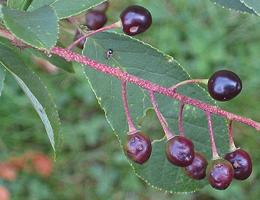 The photo to the left shows ripe mahaleb cherries on the tree. Photo by Ras The photo to the left shows ripe mahaleb cherries on the tree. Photo by Ras201105172122Prunus mahaleb
85Spice香料
  Also called Mahaleb Cherry or Rock Cherry, native to central and southern Europe, central Asia, and northwest Africa. The plant is cultivated for a spice. The spice comes from the seeds inside its fruits, either by grinding and powdering the seed kernels. It is fragrant and tastes like bitter almonds.  It is used in small quantity to sharpen sweet foods, such as sweet breads and confectionery. In Greece, it is added in a kind of braided bread that is traditionally eaten in Easter, also to make yeast cake, yeast biscuit, and Easter cheese cake. In western Asia, Mahaleb kernels are used in Lebanon and Armenian cooking, mostly ground finely to flavour breads and crackers. Tsoureki - Greek Easter Loaf Ingredients: 1kg flour, 1 cup lukewarm milk, 2 bags instant dry yeast, 1.5 cup sugar, cherry mahaleb, grated lemon rind, 1 cup shortening, 6 eggs, Methods: 1. knead and let dough rises twice. 2. Divide into three portions and each portion into another three. Roll out each portion into strip. Braid 3 strips together loosely. 3. Cover the tsoureki till they are double in size. 4. Beat lightly 1 egg with 1-2 tbs sugar and glaze the tsourekia. 5. Bake for 20 minutes or till golden brown. Health benefits anti-inflammation stimulates respiration improves digestion Toxicity This toxin is found mainly in the leaves and seed and is readily detected by its bitter taste. So do not eat if it's too bitter. --------------------------------------------------------------------------------------- hat is Mahlab?
There are many alternative spellings for this spice; mahlab, mahalab, mahleb, mahlebi or mahaleb. All of these names refer to an unusual fragrant spice made from the stones of a small, black cherry tree that grows wild in the Mediterranean region across to Turkey. It was first used for perfumes in the Middle East and Turkey, where it later became popular as a spice for flavouring breads. The world’s major producer of mahlab is now Iran, followed by Turkey and Syria..
Spice Description
Mahlab is the dried kernel of a small cherry stone. It is oval, about 5mm (3/16″) long, buff-coloured with a finely wrinkled skin and a cream-coloured interior. The powdered spice is yellowish, similar to the colour to mace. Mahlab is not readily available outside the Middle East, though you may find it in Greek or Middle Eastern markets.
Bouquet: quite sweet with notes of cherry and almond. Some describe it as resembling marzipan.
Flavour: a combination of fragrant rosewater-like sweetness and a nutty and faintly bitter, but not unpleasant aftertaste.. Hotness Scale: 1 Preparation and Storage
Mahlab is available whole or ground but, as it quickly deteriorates once ground, it is preferable to pulverise the kernels when needed. Use a pestle and mortar; a coffee grinder is ideal. Generally only small quantities of ground mahlebi are specified in recipes. Store in airtight containers.
Cooking with Mahlab
Mahlab is used widely in Mediterranean countries and the Middle East, especially Turkey, in breads, biscuits and less sweet cakes and pastries. It is well worth experimenting with this unfamiliar but intriguing flavouring. One or two spoonfuls added to a rich pastry for fresh fruit flans gives them a subtle note. Simple milk puddings can be transformed with a few pinches of mahlab and Turkish rice is given its floral fragrance and interesting taste from the spice. A traditional Greek Easter bread is flavoured with mahlab and decorated with coloured eggs. Because of its fragrant character and potential for bitterness, use it sparingly, 1/2 to 1 tsp (2 – 5 ml) to 2 cups (500 ml) of flour in a recipe.
Plant Description and Cultivation
A deciduous tree, 1-12m (3-40ft), with many spreading branches. The bark is smooth and mahogany red. The leaves, up to 6cm (2′/2ifl) long, are bright green, shiny, oval and finely toothed. The flowers are white, single, on long stalks in clusters. The fruit is small, 5-10mm (1/4-3/8in), slightly oval, green at first then black. This early flowering tree grows wild in southern Europe, Mediterranean areas, Turkey and the Levant. It is grown as an ornamental tree in other parts of Europe, including Britain. It can be propagated by seed and is used as a root stock for the sweet cherries.
Other Names
Mahalabi, Mahaleb(i), Mahlab, Mahiepi, Marlev, St Lucie’s Cherry
French: mahaleb German: Mahaleb Italian: mahaleb Spanish: mahaleb Greek: mahiepi Arabic: mahlab, mahleb Scientific Name
Prunus mahaleb
Fam: Rosaceae
Mahaleb Cherry, from seed, is 27 years old [2]
|
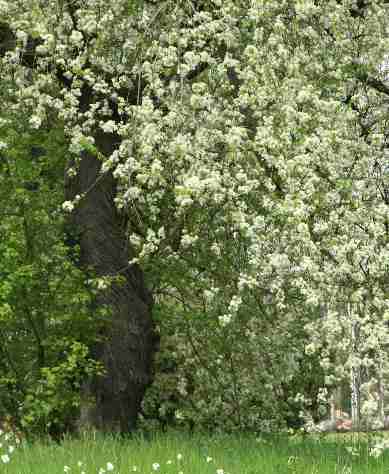

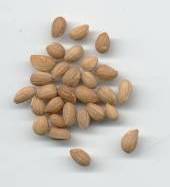
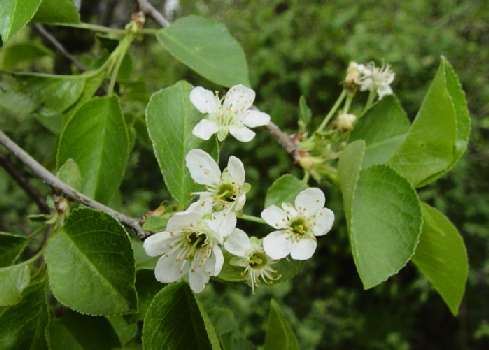
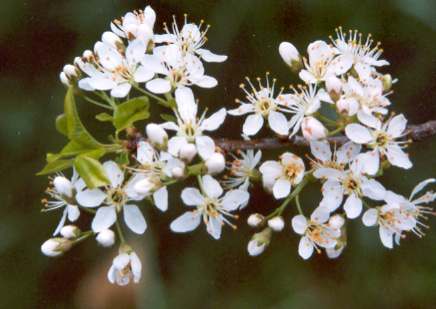
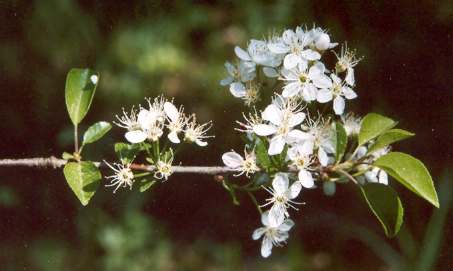
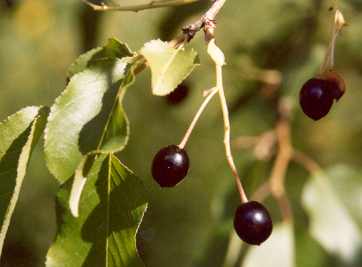
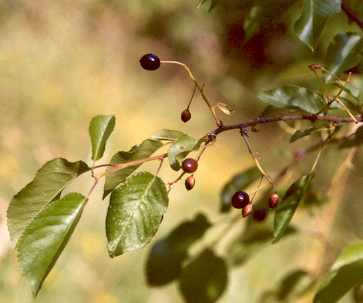
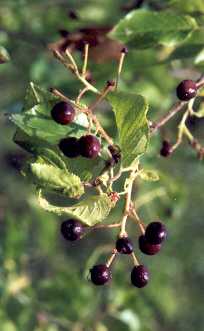
No comments:
Post a Comment